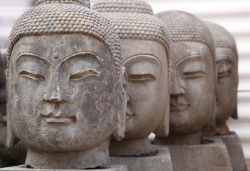Difference between revisions of "Odantapuri"
m (Text replacement - "]]]" to "]])") |
|||
| (One intermediate revision by the same user not shown) | |||
| Line 33: | Line 33: | ||
It is said they mistook the {{Wiki|universities}} with their high walls for fortresses. | It is said they mistook the {{Wiki|universities}} with their high walls for fortresses. | ||
| − | They [[thought]] the [[Buddhist]] [[monks]] were "Shaven headed [[Brahmins]]" who were idolaters. | + | They [[thought]] the [[Buddhist]] [[monks]] were "Shaven headed [[Brahmins]]" who were idolaters. ([[D. Amarasiri Weeraratne]], [[Shri Lanka]]) |
[[Odantapuri]], also called [[Odantapura]] or [[Uddandapura]], was a [[Buddhist]] [[Vihara]] in what is now {{Wiki|Bihar}}, [[India]]. | [[Odantapuri]], also called [[Odantapura]] or [[Uddandapura]], was a [[Buddhist]] [[Vihara]] in what is now {{Wiki|Bihar}}, [[India]]. | ||
Latest revision as of 19:17, 4 April 2016
- University founded in Magadha in the eighth Century by Dharmapala; regarded as the model for bsam yas. Tarthang
- one of the six Buddhist universities of ancient India
- also called Uddandapura, was a Buddhist vihara in what is now Bihar, India.
Odantapuri was considered the second oldest of India's universities.
This was situated in Maghada, about 6 miles away from Nalanda. Acharya Sri Ganga of Vickramasila had been a student here. Later he joined Odantapuri.
King Gopala (660-705) was the patron who helped to found this university.
According to the Tibetan records there were about 12,000 students at Odantapuri.
Our knowledge of this seat of learning is obscure, and we are not in a position to give more details.
This too perished at the hands of the Muslim invaders.
It is said they mistook the universities with their high walls for fortresses.
They thought the Buddhist monks were "Shaven headed Brahmins" who were idolaters. (D. Amarasiri Weeraratne, Shri Lanka)
Odantapuri, also called Odantapura or Uddandapura, was a Buddhist Vihara in what is now Bihar, India.
It was established by king Dharmapala of Pala dynasty in the 8th century.
It is considered the second oldest of India's universities and was situated in Magadha, Recently it is known as a Bihar Sharif (Head Quarter of Nalanda District).
Acharya Sri Ganga of Vikramashila had been a student here.
According to the Tibetan records there were about 12,000 students at Odantapuri. Odantpuri was situated at Hiranya Prabhat Parvat (Mountain)and the bank of River Panchanan.
In a Tibetan history of the Kalachakra Tantra called dpal dus kyi 'khor lo'i zab pa dang rgya che ba'i dam pa'i chos byung ba'i tshul legs par bshad pa ngo mtshar dad pa'i shing rta, by the Sakya master Jamgon Amye Zhab (1597–1659) ('jam mgon a myes zhabs ngag dbang kun dgad nams), it is mentioned that Odantapuri was administered by "Sendhapas," the Tibetan referent for Sri Lankan Theravadins.
A number of Monasteries grew up during the PāLa period in ancient Bengal and Magadha.
According to Tibetan sources, five great Mahaviharas stood out: Vikramashila, the premier university of the era; Nalanda, past its prime but still illustrious, Somapura Mahavihara, Odantapuri, and Jaggadala.
The five Monasteries formed a network; "all of them were under state supervision" and their existed "a system of co-Ordination among them . .
it seems from the evidence that the different seats of Buddhist learning that functioned in eastern India under the PāLa were regarded together as forming a network, an interlinked group of institutions," and it was common for great scholars to move easily from position to position among them.
The university perished, along with Nalanda, at the hands of the Ali Bakhtiar Muhammad Khilji around 1193.
Khilji's descendants would Form the Khilji dynasty in 1290 and become known for their assault on Hinduism.
